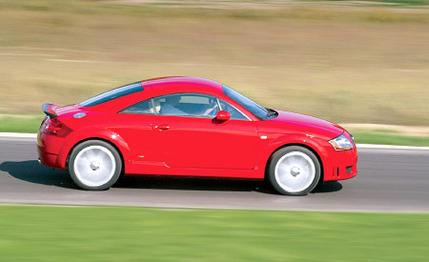 Short Take Road Test
Short Take Road Test
Of all the cars we've ever covered in our Short Take format, this may be one of the most significant. That's because it represents our first instrumented test of a production car equipped with the dual-clutch, automated manual transmission that we believe will soon become the transmission of choice across a broad swath of the automotive landscape.
The Direct Shift Gearbox is a cake-and-eat-it-too tranny of the sort engineers have spent decades striving for-one that combines the efficiency of a manual with the effortlessness of an automatic. We've reported on plenty of automated manuals over the past decade, finding some (the BMW M3's, the Ferrari Enzo's) to perform better than others (the BMW Z4's, the Toyota MR2 Spyder's).
All such systems we've tested to date use conventional manual transmissions to which are mounted little electromechanical gizmos that assume the tasks a driver's wrist, elbow, and left foot would otherwise perform in manipulating a shifter and clutch pedal. Even the quickest-shifting of these still requires a momentary gap in the power delivery, because they all must release the clutch while a new gear is selected. And that has doomed these boxes as a replacement for the conventional automatic in mainstream vehicles.
The dual-clutch concept eliminates the torque gap by releasing the clutch driving one gear just as a clutch connected to the next gear engages. Like so many good ideas that have come into production recently, this one is nothing new. It was first tried at Citroën more than 70 years ago, and it even saw duty in Porsche 962 and Audi Quattro race cars during the mid-'80s. But the primitive electronics of the day made the system difficult to tune for commercially comfortable launches and smooth shifting, and system reliability fell somewhat shy of the four-year/50,000-mile warranty target.
Today, the TT uses an onboard controller area network (CAN) to link all the sensors and control units so the engine and transmission are privy to what's going on with the brakes, stability control, and other systems. Twelve different sensors help the transmission decide when to shift while running in the automatic- or sport-shift mode (and when to block shifts to prevent overrevving or stalling of the engine when the driver is flicking the shift paddles or rowing the lever manually). All shifts are then performed with perfectly matched engine revs. Gentle launches are comfortable, although experts will note that the wet multiplate clutch doesn't launch quite as imperceptibly as a conventional automatic's torque converter can.
At the test track with the stability control switched off, the computer delivered a good strong launch with modest wheelspin that resulted in a 5.9-second sprint to 60 mph and a 14.3-second quarter-mile at 97 mph. That's quicker than the lighter, 225-hp four-cylinder TT Quattro by 0.3 to 0.4 second. Sharing credit for this improvement is the engine's output advantage of 25 horsepower and 29 pound-feet of torque, gearing that's about 19 percent shorter in the first four gears, and the fact that the car keeps pulling during each of the 0.2-second shifts along the way.
One other instance in which the DSG doesn't behave like a slushbox is in deep downshifts: Floor the pedal while cruising at 45 mph in sixth gear, and instead of going straight to second, as a conventional automatic could, DSG has to step briskly down through the gears. Still, its 50-to-70-mph passing time of 4.1 seconds bests even the no-gears-to-shift Audi A4 3.0 CVT's by more than a second.
This engine and transmission really shine in the TT. With no turbo lag and 3.2 liters' worth of V-6 torque on tap, it just comes across as a much more lively and engaging sports coupe. The beefier anti-roll bars and stiffened suspenders help elevate lateral grip a couple points to 0.87 g, and the bigger brakes stop better than the 225-hp TT's do, in 164 feet from 70 mph.
At $40,620, the 3.2 Quattro model starts at $3200 more than the 1.8T Quattro six-speed manual with 225 horsepower (the 180-hp engine now comes mounted to the TT lineup's only six-speed automatic). That strikes us as a reasonable price to pay to be one of the first in your car klatch to show off the transmission of the future. This same concept will soon power the 987-hp Bugatti EB16.4 Veyron. Wait for that one, and you'll need $1.2 million!